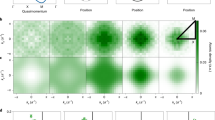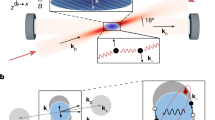Abstract
Exchange-antisymmetric pair wavefunctions in fermionic systems can give rise to unconventional superconductors and superfluids1,2,3. The realization of these states in controllable quantum systems, such as ultracold gases, could enable new types of quantum simulations4,5,6,7,8, topological quantum gates9,10,11 and exotic few-body states12,13,14,15. However, p-wave and other antisymmetric interactions are weak in naturally occurring systems16,17, and their enhancement via Feshbach resonances in ultracold systems has been limited by three-body loss18,19,20,21,22,23,24. Here we create isolated pairs of spin-polarized fermionic atoms in a multiorbital three-dimensional optical lattice. We spectroscopically measure elastic p-wave interaction energies of strongly interacting pairs of atoms near a magnetic Feshbach resonance. The interaction strengths are widely tunable by the magnetic field and confinement strength, and yet collapse onto a universal curve when rescaled by the harmonic energy and length scales of a single lattice site. The absence of three-body processes enables the observation of elastic unitary p-wave interactions, as well as coherent oscillations between free-atom and interacting-pair states. All observations are compared both to an exact solution using a p-wave pseudopotential and to numerical solutions using an ab initio interaction potential. The understanding and control of on-site p-wave interactions provides a necessary component for the assembly of multiorbital lattice models25,26 and a starting point for investigations of how to protect such systems from three-body recombination in the presence of tunnelling, for instance using Pauli blocking and lattice engineering27,28.
This is a preview of subscription content, access via your institution
Access options
Access Nature and 54 other Nature Portfolio journals
Get Nature+, our best-value online-access subscription
$29.99 / 30 days
cancel any time
Subscribe to this journal
Receive 51 print issues and online access
$199.00 per year
only $3.90 per issue
Buy this article
- Purchase on Springer Link
- Instant access to full article PDF
Prices may be subject to local taxes which are calculated during checkout




Similar content being viewed by others
Data availability
Source data are provided with this paper.
References
Volovik, G. The Universe in a Helium Droplet, International Series of Monographs on Physics (Clarendon Press, 2003).
Ivanov, D. A. Non-Abelian statistics of half-quantum vortices in p-wave superconductors. Phys. Rev. Lett. 86, 268–271 (2001).
Mizushima, T. et al. Symmetry-protected topological superfluids and superconductors: from the basics to 3He. J. Phys. Soc. Jpn 85, 022001 (2016).
Botelho, S. S. & Sá de Melo, C. A. R. Quantum phase transition in the BCS-to-BEC evolution of p-wave Fermi gases. J. Low Temp. Phys. 140, 409–428 (2005).
Gurarie, V., Radzihovsky, L. & Andreev, A. V. Quantum phase transitions across a p-wave Feshbach resonance. Phys. Rev. Lett. 94, 230403 (2005).
Cheng, C.-H. & Yip, S.-K. Anisotropic Fermi superfluid via p-wave Feshbach resonance. Phys. Rev. Lett. 95, 070404 (2005).
Levinsen, J., Cooper, N. R. & Gurarie, V. Strongly resonant p-wave superfluids. Phys. Rev. Lett. 99, 210402 (2007).
Zhao, E. & Liu, W. V. Orbital order in Mott insulators of spinless p-band fermions. Phys. Rev. Lett. 100, 160403 (2008).
Tewari, S., Das Sarma, S., Nayak, C., Zhang, C. & Zoller, P. Quantum computation using vortices and majorana zero modes of a px + ipy superfluid of fermionic cold atoms. Phys. Rev. Lett. 98, 010506 (2007).
Zhang, C., Tewari, S. & Das Sarma, S. Bell’s inequality and universal quantum gates in a cold-atom chiral fermionic p-wave superfluid. Phys. Rev. Lett. 99, 220502 (2007).
Nayak, C., Simon, S. H., Stern, A., Freedman, M. & Das Sarma, S. Non-Abelian anyons and topological quantum computation. Rev. Mod. Phys. 80, 1083–1159 (2008).
Jona-Lasinio, M., Pricoupenko, L. & Castin, Y. Three fully polarized fermions close to a p-wave Feshbach resonance. Phys. Rev. A 77, 043611 (2008).
D’Incao, J. P., Esry, B. D. & Greene, C. H. Ultracold atom-molecule collisions with fermionic atoms. Phys. Rev. A 77, 052709 (2008).
Nishida, Y., Moroz, S. & Son, D. T. Super Efimov effect of resonantly interacting fermions in two dimensions. Phys. Rev. Lett. 110, 235301 (2013).
Wang, Y., D’Incao, J. P. & Greene, C. H. Universal three-body physics for fermionic dipoles. Phys. Rev. Lett. 107, 233201 (2011).
Martin, M. J. et al. A quantum many-body spin system in an optical lattice clock. Science 341, 632–636 (2013).
Lemke, N. D. et al. p-wave cold collisions in an optical lattice clock. Phys. Rev. Lett. 107, 103902 (2011).
Regal, C. A., Ticknor, C., Bohn, J. L. & Jin, D. S. Tuning p-wave interactions in an ultracold Fermi gas of atoms. Phys. Rev. Lett. 90, 053201 (2003).
Suno, H., Esry, B. D. & Greene, C. H. Recombination of three ultracold fermionic atoms. Phys. Rev. Lett. 90, 053202 (2003).
Zhang, J. et al. p-wave Feshbach resonances of ultracold 6Li. Phys. Rev. A 70, 030702 (2004).
Schunck, C. H. et al. Feshbach resonances in fermionic 6Li. Phys. Rev. A 71, 045601 (2005).
Günter, K., Stöferle, T., Moritz, H., Köhl, M. & Esslinger, T. P-wave interactions in low-dimensional fermionic gases. Phys. Rev. Lett. 95, 230401 (2005).
Chevy, F. et al. Resonant scattering properties close to a p-wave Feshbach resonance. Phys. Rev. A 71, 062710 (2005).
Waseem, M., Yoshida, J., Saito, T. & Mukaiyama, T. Unitarity-limited behavior of three-body collisions in a p-wave interacting Fermi gas. Phys. Rev. A 98, 020702 (2018).
Li, X. & Liu, W. V. Physics of higher orbital bands in optical lattices: a review. Rep. Prog. Phys. 79, 116401 (2016).
Dutta, O. et al. Non-standard Hubbard models in optical lattices: a review. Rep. Prog. Phys. 78, 066001 (2015).
Han, Y.-J. et al. Stabilization of the p-wave superfluid state in an optical lattice. Phys. Rev. Lett. 103, 070404 (2009).
Fedorov, A. K., Yudson, V. I. & Shlyapnikov, G. V. p-wave superfluidity of atomic lattice fermions. Phys. Rev. A 95, 043615 (2017).
Alicea, J. New directions in the pursuit of Majorana fermions in solid state systems. Rep. Prog. Phys. 75, 076501 (2012).
Chang, Y.-T., Senaratne, R., Cavazos-Cavazos, D. & Hulet, R. G. Collisional loss of one-dimensional fermions near a p-wave Feshbach resonance. Phys. Rev. Lett. 125, 263402 (2020).
Marcum, A. S., Fonta, F. R., Mawardi Ismail, A. & O’Hara, K. M. Suppression of three-body loss near a p-wave resonance due to quasi-1D confinement. Preprint at https://doi.org/10.48550/arXiv.2007.15783 (2020).
Idziaszek, Z. Analytical solutions for two atoms in a harmonic trap: p-wave interactions. Phys. Rev. A 79, 062701 (2009).
Kanjilal, K. & Blume, D. Nondivergent pseudopotential treatment of spin-polarized fermions under one- and three-dimensional harmonic confinement. Phys. Rev. A 70, 042709 (2004).
Gaebler, J. P., Stewart, J. T., Bohn, J. L. & Jin, D. S. P-wave Feshbach molecules. Phys. Rev. Lett. 98, 200403 (2007).
Stöferle, T., Moritz, H., Günter, K., Köhl, M. & Esslinger, T. Molecules of fermionic atoms in an optical lattice. Phys. Rev. Lett. 96, 030401 (2006).
Hartke, T., Oreg, B., Jia, N. & Zwierlein, M. Quantum register of fermion pairs. Nature 601, 537–541 (2022).
Müller, T., Fölling, S., Widera, A. & Bloch, I. State preparation and dynamics of ultracold atoms in higher lattice orbitals. Phys. Rev. Lett. 99, 200405 (2007).
Fuchs, J. et al. Binding energies of 6Li p-wave Feshbach molecules. Phys. Rev. A 77, 053616 (2008).
Busch, T., Englert, B.-G., Rzażewski, K. & Wilkens, M. Two cold atoms in a harmonic trap. Found. Phys. 28, 549–559 (1998).
Ticknor, C., Regal, C. A., Jin, D. S. & Bohn, J. L. Multiplet structure of Feshbach resonances in nonzero partial waves. Phys. Rev. A 69, 042712 (2004).
Ahmed-Braun, D. J. M. et al. Probing open- and closed-channel p-wave resonances. Phys. Rev. Res. 3, 033269 (2021).
Inada, Y. et al. Collisional properties of p-wave Feshbach molecules. Phys. Rev. Lett. 101, 100401 (2008).
Foster, M. S., Gurarie, V., Dzero, M. & Yuzbashyan, E. A. Quench-induced floquet topological p-wave superfluids. Phys. Rev. Lett. 113, 076403 (2014).
Tokura, Y. & Nagaosa, N. Orbital physics in transition-metal oxides. Science 288, 462–468 (2000).
Imada, M., Fujimori, A. & Tokura, Y. Metal-insulator transitions. Rev. Mod. Phys. 70, 1039–1263 (1998).
Mamaev, M. et al. Collective p-wave orbital dynamics of ultracold fermions. Phys. Rev. Lett. 127, 143401 (2021).
Bakr, W. S. et al. Orbital excitation blockade and algorithmic cooling in quantum gases. Nature 480, 500–503 (2011).
Mamaev, M., Thywissen, J. H. & Rey, A. M. Quantum computation toolbox for decoherence-free qubits using multi-band alkali atoms. Adv. Quantum Technol. 3, 1900132 (2020).
Marco, L. D. et al. A degenerate Fermi gas of polar molecules. Science 363, 853–856 (2019).
Duda, M. et al. Long-lived fermionic Feshbach molecules with tunable p-wave interactions. Preprint at https://doi.org/10.48550/arXiv.2202.06940 (2022).
Edge, G. J. A. et al. Imaging and addressing of individual fermionic atoms in an optical lattice. Phys. Rev. A 92, 063406 (2015).
Anderson, R. et al. Conductivity spectrum of ultracold atoms in an optical lattice. Phys. Rev. Lett. 122, 153602 (2019).
Omont, A. On the theory of collisions of atoms in Rydberg states with neutral particles. J. Phys. France 38, 1343–1359 (1977).
Mentink, J. & Kokkelmans, S. Two interacting atoms in an optical lattice site with anharmonic terms. Phys. Rev. A 79, 032709 (2009).
Acknowledgements
We acknowledge insightful discussions with F. Chevy and S. Zhang and helpful manuscript comments from J. Bohn, A. Kaufman and R. Learn. This work is supported by the AFOSR grants FA9550-19-1-0275, FA9550-19-1-7044 and FA9550-19-1-0365, by ARO W911NF-15-1-0603, by the NSF’s JILA-PFC PHY-1734006 and PHY-2012125 grants, by NIST and by NSERC.
Author information
Authors and Affiliations
Contributions
V.V., P.X., F.C., C.J.F. and J.H.T. developed the experimental techniques and collected the data. V.V., P.X., M.M., F.C. and C.J.F. performed the data analysis. M.M., T.B., C.J.F., J.P.D’I. and A.M.R. developed the theoretical models. All authors contributed to writing the manuscript.
Corresponding authors
Ethics declarations
Competing interests
The authors declare no competing interests.
Peer review
Peer review information
Nature thanks Xiaopeng Li and the other, anonymous, reviewer(s) for their contribution to the peer review of this work.
Additional information
Publisher’s note Springer Nature remains neutral with regard to jurisdictional claims in published maps and institutional affiliations.
Supplementary information
Supplementary Information
This file contains Supplementary text, equations and references.
Source data
Rights and permissions
Springer Nature or its licensor (e.g. a society or other partner) holds exclusive rights to this article under a publishing agreement with the author(s) or other rightsholder(s); author self-archiving of the accepted manuscript version of this article is solely governed by the terms of such publishing agreement and applicable law.
About this article
Cite this article
Venu, V., Xu, P., Mamaev, M. et al. Unitary p-wave interactions between fermions in an optical lattice. Nature 613, 262–267 (2023). https://doi.org/10.1038/s41586-022-05405-6
Received:
Accepted:
Published:
Issue Date:
DOI: https://doi.org/10.1038/s41586-022-05405-6
This article is cited by
-
Ultracold Feshbach molecules in an orbital optical lattice
Nature Physics (2023)
Comments
By submitting a comment you agree to abide by our Terms and Community Guidelines. If you find something abusive or that does not comply with our terms or guidelines please flag it as inappropriate.



